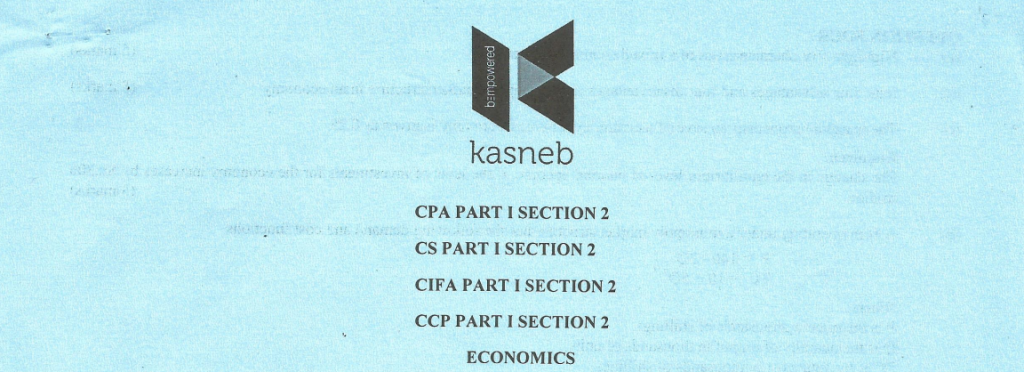
Download Economics May 2019 Past Paper
Download
We are working to provide all the answers to the questions in this past paper. You can contribute in this forum by: posting your suggested answers and voting on the posted answers in the comment box below here.
CPA PART I SECTION 2
CS PART I SECTION 2
CIFA PART I SECTION 2
CCP PART I SECTION 2
ECONOMICS
TUESDAY: 21 May 2019. Time Allowed: 3 hours.
Answer any FIVE questions. ALL questions carry equal marks.
QUESTION ONE
(a) (i) Explain the Keynesian liquidity preference theory of demand for money. (1 mark)
(ii) Outline five criticisms of the theory in (a) (i) above. (5 marks)
(b) (i) Distinguish between “perfect oligopoly” and “imperfect oligopoly”. (2 marks)
(ii) Describe three methods used in fixing prices under the oligopoly market structure. (6 marks)
(c) Highlight six factors that might lead to a rightward shift of the optimal point of a firm. (6 marks) (Total: 20 marks)
QUESTION TWO
(a) (i) Enumerate five characteristics of a free market economic system. (5 marks)
(ii) State five advantages of a free market economic system. (5 marks)
(b) Summarise five factors that could lead to a leftward shift of the supply curve of a commodity. (5 marks)
(c) The demand and average cost functions of a hypothetical firm are represented the following functions (in thousands):
Where:
P is the unit price in shillings.
Q is the quantity of output in units.
AC is the average cost in shillings.
Required:
(1) The total cost function. (1 mark)
(ii) The variable cost function. (1 mark)
(iii) The total profit of the firm When Q=10 units. (3 marks) (Total: 20 marks)
QUESTION THREE
(a) (i) Explain the difference between the “cardinal approach” and the “ordinal approach” to measuring utility. (2 marks)
(ii) Outline four limitations of the cardinal approach to measuring utility. (4 marks)
(b) Highlight six factors that determine the effectiveness of trade unions in a society. (6 marks)
(c) Discuss four applications of elasticity of demand in economic decision making. (8 marks) (Total: 20 marks)
QUESTION FOUR
(a) With the aid of a well labelled diagram, explain the equilibrium level of a firm operating under an oligopolistic market structure. (5 marks)
(b) Summarise five reasons why the prices of agricultural products fluctuate more than the prices of manufactured products. (5 marks)
(c) Suggest five policy measures that could be adopted a government to enhance geographical mobility of labour within a country. (5 marks)
(d) The table below shows the quantity of units produced a certain firm and the corresponding total cost:
Units produced Total cost (Sh.”000″)
0 77
2 216
4 235
6 319
8 348
10 382
Required:
(i) The average variable costs when the units produced are 2, 6 and 10 respectively. (3 marks)
(ii) The marginal costs of production for the 4th and 8ffi units respectively. (2 marks) (Total: 20 marks)
QUESTION FIVE
(a) Differentiate between “demand deficient unemployment” and “disguised unemployment” as used in economics. (2 marks)
(b) Enumerate four effects of inflation on the functions of money.
(c) Outline six limitations of the theory of comparative advantage as used in international trade.
(d) The following data relate to the consumption function of a hypothetical economy in millions of shillings:
C = 300 + 0.6y
Where:
C is the consumption function. y is the national income.
Required:
(i) The investment function.
(ii) Discuss seven factors that determine the level of consumption in an economy. (7 marks) (Total: 20 marks)
QUESTION SIX
(a) Examine three roles of foreign exchange reserves in an economy. (3 marks)
(b) Describe six factors that determine the terms of trade in a country. (6 marks)
(c) Explain six causes of high levels of external debt in developing countries. (6 marks)
(d) Analyse five functions of non-banking financial institutions in an economy. (5 marks) (Total: 20 marks)
QUESTION SEVEN
(a) Argue six cases against the use of national income statistics to compare the standards of living between countries. (6 marks)
(b) With the aid of an appropriate diagram, explain the relatioRship between the short run average cost curve and the long run average cost curve. (4 marks)
(c) The following information relates to the commodity and money markets of a certain closed economy in millions of shillings:
Commodity market
C = 200 + 0.4y
I = 1,900 — 12r
Money market
MDT = 0.5y
MDS = 100 — lOr MS 1,500
Where: C = Consumption function
y = National income
I = Investment function
r Rate of interest
MDT = Precautionary and transactionary demand for money
MDS Speculative demand for money
MS Money supply
Required:
(i) The IS function. (3 marks)
(ii) The LM function. (3 marks)
(iii) The equilibrium level of interest rate. (2 marks)
(iv) The equilibrium level of national income. (2 marks)
(Total: 20 marks)
